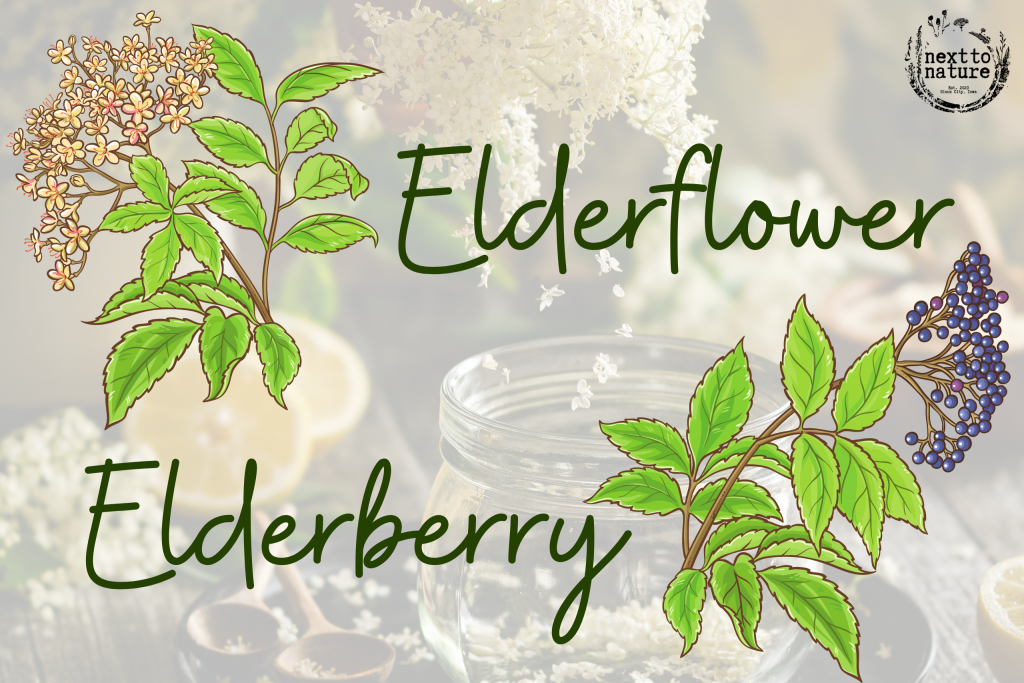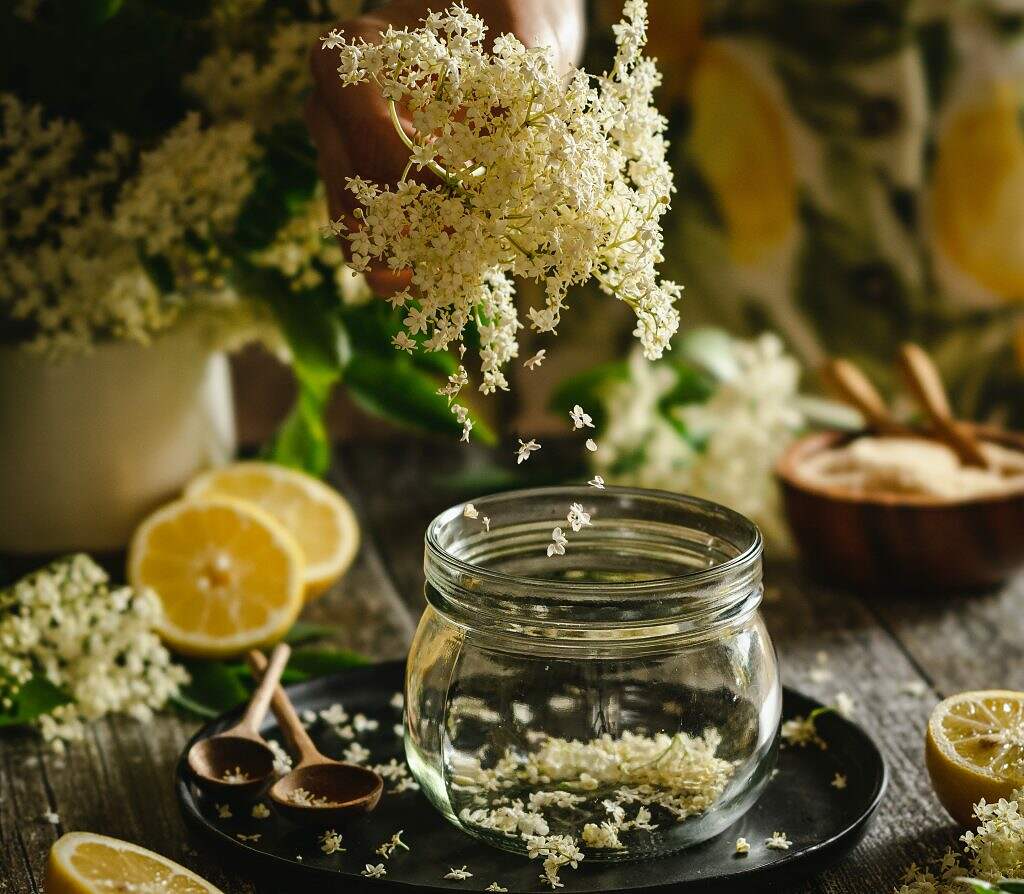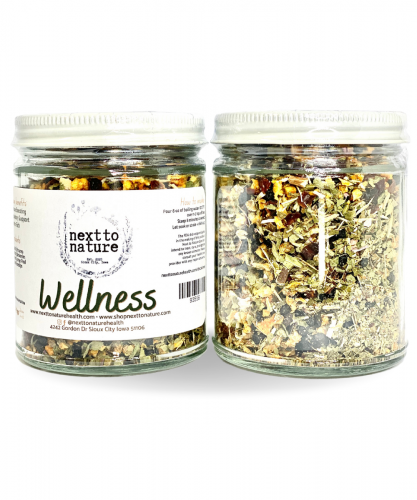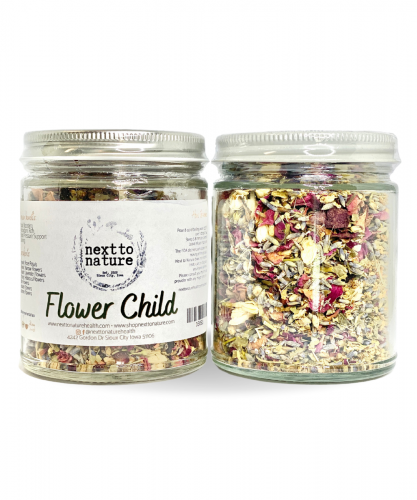Let’s discuss the “about this plant” fun facts first before we dive into the questions around elderberries and elder flower.
ELDER
Sambucus nigra L. ssp. canadensis (L.)
Parts Used: Flower (dried), berry (cooked)
Geographic Distribution: Asia, Africa, Europe, North America
Key Constituents: Berries: vitamin C, anthocyanins, flavonoids. Flowers: mucilage, flavonoids, volatile oil, quercetin, free fatty acids, triterpenes, phenolic acid, minerals, sterols, sugars, tannins. Leaves: Cyanogenic glycosides
Harvesting Guidelines: Elderflowers are removed from the base of the flower cluster stalk. Only remove a few clusters from a tree, so that the tree can produce berries later in the year. Berries should be fully ripe before harvesting – do not pick green or unripe berries. Harvest the berry stalk and then separate the berries from the stems.

If you’re on a journey or continuing to use natural remedies for ailments such as a cold, you’ve probably heard of elderberries. Perhaps you already use them. For those of you who have just begun using elderberries, let us share some answers to the most common questions we get about elderberries as a way to help them and their families stay healthy all year round.
1] What exactly is it? Maybe you’ve heard of elderberry but you’re not exactly sure what it even is.
Elderberries are a dark purple fruit that comes from the Elder flower. It is a rich source of antioxidants known as anthocyanins. Although there’s no one-size-fits-all remedy for illness, supporters of elderberry say the fruit is one of nature’s most versatile solutions for what ails you. There are about 30 types of elder plants and trees around the world. Sambucus nigra, which is known as the European version, is most closely connected to your health and healing. Historically it dates back as far as 400 BC. At this time Hippocrates, the “Father of Medicine,” called the elder tree his “medicine chest.” Today, the elderberry is considered one of the world’s most healing plants in modern folk medicne.
Some people believe elderberries are effective in treating the common cold, flu, constipation, hay fever, and sinus infections. Others claim it to be useful in treating toothache, sciatica, and burns as well. Some of these claims have more evidence than others.
Just as uses for elderberry are broad, the forms it comes in are many, including syrups, gummies, lozenges, pills, and teas. It is also used in:
- Food coloring
- Body lotions
- Jams
- Wine
2] What are the health benefits? How does it help?
The berries and flowers are packed with antioxidants and vitamins that may boost your immune system. They could help tame inflammation, lessen stress, and help protect your heart, too. Some experts recommend elderberry to help prevent and ease cold and flu symptoms.
It has also been used as a treatment for:
- Constipation
- Joint and muscle pain
- Infections that affect how you breathe
- Headaches
- Fever
- Kidney problems
- Epilepsy
- Minor skin conditions
- Stress
- HIV and AIDS
Elderberry gets a lot of support as a healing agent through word of mouth and old wives’ tales, but its success in medical tests is less definite.
3] Can I take it every day?
Yes, you can take elderberry supplements daily, even three to four times a day. However, you should not take more than the recommended daily dose. Elderberry is a widely-used medical plant. Elderberry supplements are commonly taken to treat colds and flu.
4] Is it safe for kids?
You can give your kids a small daily dose of elderberry during cold and flu season to strengthen their immune system. Or you can use it only during an acute illness like a cold or the flu. If your child is under the age of 2, you should discuss with a health practitioner. The Next to Nature Wellness herbal tea is a great family health go-to!
5] Who should not take elderberries?
Unripe or uncooked berries or flowers from the plant can cause nausea, vomiting, and diarrhea. Larger amounts can cause even more serious poisoning.
Other things to keep in mind:
- If you are pregnant or breastfeeding, you shouldn’t take it.
- Other parts of the elder tree, including the branches, twigs, leaves, roots, and seeds, are toxic. They have a type of cyanide called glycoside.
- People with immune problems might have reactions to elderberry.
- If you get a rash or have trouble breathing after you have some, you might be allergic.
- Because it’s a diuretic, be careful when you take it if you’re also using medicines that make you pee more.
Know you source, prepare the plant properly and follow dosage guidelines. This goes for any plant use!
To wrap up, elderflower and elderberry are both exceptional allies during colds, flu, and respiratory infections due to their diaphoretic and antiviral actions. Taken as a hot tea (or tincture), elderflowers move energy and qi outward by stimulating circulation and promoting sweating. This process removes toxins from the body and reduces fevers by killing pathogens. Elderflower is also anti-inflammatory, anti-catarrhal and expectorant, and helps in cases of colds, sinusitis and sinus allergies to reduce inflammation of sinus tissue and allow for the movement of congestion. Research reviewed by Ulbricht, suggests that “herbal preparations containing elder may result in less swelling of mucus membranes, better drainage, milder headache, and decreased nasal congestion.” Elderberry is also effective for coughs and congestion associated with lower respiratory viral infections, promoting expectoration of mucus associated with bronchial infections.

Adult Dose
Tea: 1-2 teaspoons flowers per cup boiling water, steeped for 10-15 minutes, taken three times per day.
Tincture: 2-4 mL (1:5 in 40%) elderflower tincture, taken three times per day. Syrup: 2-3 teaspoons elderberry syrup, taken 3-4 times per day.
Dosage information from Medical Herbalism by David Hoffmann.
Safety
Elder bark, leaves, roots, seeds, and unripe berries contain alkaloids and cyanogenic glycosides, which may cause nausea, vomiting, and diarrhea as well as depression of the central nervous and respiratory systems. The emetic (vomiting) action and other toxicity reactions are caused by the release of hydrogen cyanide (HCN) from cyanogenic glycosides. This occurs during the act of macerating the plant during chewing. The consumption of fresh plant parts is what causes the reaction. Cooking or drying reduces the cyanogenic glycoside content.
Under the guidance of a highly skilled herbalist, the fresh bark can be used as an emetic and purgative. As for the elderflowers, they are considered safe even for small children. The ripe fresh berries are also safe. Though do not consume in high quantities or if you’re sensitive to the compounds in the plant. However, cooking or drying them is the safest approach. Due to its diuretic effects, use caution if taking with drugs that increase urination.
What can you find in our store with this powerful plant?
We have our Wellness and Flower Child herbal tea blends as well as elderberry syrup and an elderflower tincture.


Stay connected with nature! Join us on the journey to healthy living.
Instagram: https://www.instagram.com/nexttonaturehealth/
Facebook: https://www.facebook.com/nexttonaturehealth
Online Shop: https://www.shopnexttonature.com/
More herbal education for you?
Sources:
Healthline
Very Well
Medicine Net
Herbarium The Herbal Academy
Chevallier, 2000
WebMD
Ulbricht, 2014
American Botanical Council, 2004;
Gardner & McGuffin, 2013
Magnuson, 1997
American Botanical Council, 2004
Buhner 2013
